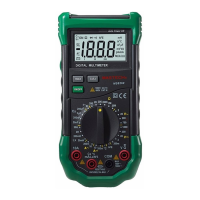capacitors before conducting the Humming
ON/OFF test.
11
To conduct ON/OFF tests:
1. Set the rotary switch at the
position.
2. Connect the black measuring tip and the red
measuring tip to the COM input socket and the Ω
input socket, respectively.
3. Measuring the resistance of the circuit to be tested
with the other ends of the measuring tips.
4. When conducting ON/OFF tests, if the resistance of
the circuit to be test is not greater than about 60Ω,
the buzzer will hum.
3.2.5 Measuring capacitance
In order to prevent the meter or the equipment to
be measured from being damaged, always turn
off all power supplies for the circuit to be
measured and discharge all high-voltage
capacitors before measuring capacitance. Make
sure that the capacitors have been discharged
with the switch at the position of DC voltage.
The ranges for capacitance of this meter are 20.00nF,
200.0nF, 2.000µF, and 200.0µF.
To measure capacitance
1. Set the rotary switch at a proper position, and press down
the “Cx /Lx” key.
2. Connect the black measuring tip and the red measuring
tip to the COM input socket and the CX input socket.
(You can also use the dedicated multi-functional test
sockets to measure capacitance).
3. Measure the capacitance of the capacitor to be tested
with the other ends of the test tips, and read the
measured value from LCD.
The following are some tips for measuring capacitance:
When conducting measurements on capacitors with high
capacitance with this meter, it takes some time to obtain
a stable value.
In order to improve the precision for the measured value
low than 20nF, please deduct the distributive capacitance
of the meter and wires.
3.2.6 Transistor measurement
Do not apply a voltage higher than DC 250V or AC
(effective voltage) across the common terminal
and the hFE terminal in order to avoid electric
shock and/or damaging the meter.
1. Set the rotary switch at the position of hFE.
12
2. Connect the multi-functional test sockets to the meter with
correct connections (the “+” terminal plug of the dedicated
multi-functional test apparatus should be connected to the
hFE terminal of the meter, and the “COM” plug to the
common end).
3. Determine whether the transistor is of NPN type or PNP
type, then plug the three ends (e, b, c) of the transistor into
the corresponded holes on the dedicated multi-functional
test sockets.
4. Read the value from LCD, which approximately equals to

